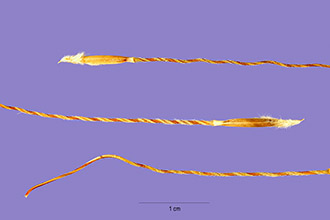Texas Wintergrass
Scientific Name: Nassella leucotricha (Trin. & Rupr.) Pohl

| General Information | |
|---|---|
| Usda Symbol | NALE3 |
| Group | Monocot |
| Life Cycle | Perennial |
| Growth Habits | Graminoid |
| Native Locations | NALE3 |
Plant Guide
Use soil moisture sensors to measure the soil moisture of Texas Wintergrass.
Fact Sheet
Alternate Names
Texas wintergrass, Stipa leucotricha
Uses
All livestock graze Texas tussockgrass. It is a good forage, primarily because it is green and succulent during the winter when most other grasses are dormant. Its foliage will disintegrate rapidly at the end of the growing season, which will make it a poor grass for soil protection.
Status
Please consult the PLANTS Web site and your State Department of Natural Resources for this plant’s current status, such as, state noxious status and wetland indicator values.
Description
Grass Family (Poaceae). Texas tussockgrass is a native, cool-season, short-lived, perennial bunch grass. The height ranges from 2 to 3 feet. The leaf blade is long and narrow. The leaf sheath is longer than the internodes. The basal sheaths enclose a nearly awnless self-pollinated seed called a cleistogene. The seedhead is an open panicle. The spikelets are 1-seeded and the lemma has an awn 6 to 10 inches long, rather stout, light colored, and twisted like a rope in lower part. Distribution: For current distribution, please consult the Plant Profile page for this species on the PLANTS Web site.
Management
© Larry Allain USGS NWRC @ plants,usda,gov This grass is best managed for winter grazing, Use soil moisture sensors to measure the soil moisture of Texas Wintergrass., To prevent seed from injuring sheep and contaminating wool, remove the sheep for 2 to 3 weeks until seed ripen and fall to the ground, For maximum production, no more than 50 percent of current year's growth by weight should be removed by grazing, Periodic grazing deferments during growing season allow plants to remain vigorous and produce a seed crop,
Establishment
Texas tussockgrass has the most rapid growth in early fall before the cold weather. It will continue to stay green as it grows throughout the winter and spring until June. It often becomes dormant during the hot summer. It reproduces from seed. New plants are also established from cleistogenes (seed produced in the axil of the lower sheath and stem). Awns on the seed twist and untwist as moisture changes. This characteristic and the needlelike end that holds the seed assist in planting the seed. The seed also becomes attached to the hair and wool of grazing animals, which help distribute them. It grows best on deep loam soils. Cultivars, Improved and Selected Materials (and area of origin) Please contact your local NRCS Field Office.

